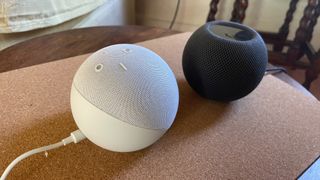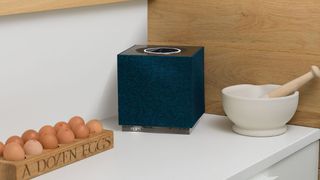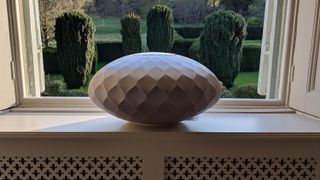8 things to consider before buying a Bluetooth speaker
Want to welcome a Bluetooth speaker into the family? Read this checklist first

If you're a music lover who hasn't yet ditched the cables and gone wireless, it might be time to think about a more portable, versatile option for your music. The best Bluetooth speakers will help you break free from the restrictions of cords and cables without compromising too heavily on sound.
Bluetooth tech and portable audio have become big business in recent years, meaning there's now a plethora of wire-free, one-box models from which to choose – everything from wonderfully sophisticated speakers from Sonos and Dali to more rugged, outdoorsy options from JBL that deliver great sound per pound.
This, coincidentally, leads us to the point of this article, in that there are a number of things you should consider before buying a Bluetooth speaker, including its portability, feature set, design and, inevitably, sound. After all, what's best for one person might not be what's best for your preferences and requirements.
With our definitive, step-by-step guide to buying a Bluetooth speaker, you will be well-informed by the time you actually make a purchase.
Is it portable?

Some Bluetooth speakers, such as the dinky JBL Go 3, are no bigger than a bar of soap or your smartphone. Others are weightier affairs designed to dominate a sideboard like a fine sculpture but that aren't so accustomed to being taken abseiling down the side of a cliff.
Travel speakers such as the five-star Tribit Stormbox Micro 2 or the Go 3 are perfect for packing into luggage or simply carrying around town with your mates. They aim to balance decent sound quality and loudness with maximum portability, and the five-star Micro 2 does a stellar job of doing just that.
As a general rule, the larger the Bluetooth speaker, the beefier the sound, although some units do give you more bang for your buck than others. The excellent Audio Pro Addon C10 MkII, for example, boasts a 13cm mid-bass driver and an 80W class D amplifier. Impressive, but it is a speaker intended more for emitting music in a home environment than an outdoor one.
Of course, for a Bluetooth speaker to be truly portable it must have a built-in battery. and therefore not require being tethered to a mains socket. Battery life tends to be around six to 12 hours for most models, while some last up to 24 hours, and we'd recommend something that offers a minimum of 12+, especially as such given lengths can be upper estimates which drop when the speaker is played more loudly than usual. One of our favourite portable speakers, the JBL Flip 6, lasts for 12 hours on a single charge, but its larger sibling, the Award-winning Charge 5, holds out for an impressive 20 hours before needing to be re-juiced.
Again, there's usually a trade-off here with the competing demands of size, portability and battery life. Bigger units tend to give greater battery life and a bigger sound (because the drive units can be larger and wider apart), but they do sacrifice ultimate portability in the process. Small speakers will grant ease of use but tend to drain quicker and not give you quite so much heft, while stationary speakers (almost) always plug into the mains supply and so don't run into this problem.
For a decent middle ground at a reasonable price, we'd tend to lean towards recommending the JBL Flip 6 or the Charge 5 as they sit in at a happy medium between these integral factors.
Is it Bluetooth 4 or 5?

You might be reading this particular subheading and thinking that there's only one version of Bluetooth, and it's called... Bluetooth. If you're not that au fait with the revolutionary tech, check out our Bluetooth 5.0 explainer, which will give you all you need to know about the latest developments in the field.
Version 1 of Bluetooth appeared back in 1999 if you can believe it. These days, most Bluetooth speakers use version 5 or even 5-point-something or other, with the older v4.2 now a little dated (albeit part of some veteran but still recommendable models such as the JBL Flip 5 and Audio Pro Addon C3). It might not sound like a big difference, but opting for Bluetooth 5 can drastically alter the appeal of a speaker.
Crucially, the wireless range of Bluetooth version 5.0 is four times that of Bluetooth 4-point-anything, maxing out at a whopping 120 metres; version 4.2 maxes out at about 30 metres. It's also worth noting that version 5 is faster than version 4. Bluetooth 5 clocks up speeds of 2Mbps and is compatible with a slew of smart home devices, too, whereas version 4.1 hits the redline at 1Mbps.
Lastly, almost all smartphones today tote Bluetooth 5.0 and above. They're backwards compatible with older Bluetooth versions, but with Bluetooth 5.0, you can pair multiple devices to one speaker – useful for those with families or who live in shared houses.
Is it waterproof?

Waterproofing ratings, to the uninitiated, can seem even more opaque and hard to grasp than Bluetooth ratings, but our IP ratings explainer piece should have you covered if you're still unsure as to what it all means. Put simply, since water and electronics don't mix, IP ratings denote how waterproof and dustproof a piece of electronic equipment is, with the first value after 'IP' denoting dust protection and the second denoting water protection. And most Bluetooth speakers will have one.
Unless you're going to use a Bluetooth speaker for purely home use (and there's no harm in doing so with some of the finer domestic models), a decent IP rating is integral for ensuring your new kit doesn't disintegrate the moment a mist of drizzle inevitably descends upon the family barbecue.
Take the Bang & Olufsen Beosound A1 (2nd gen): it's rated water and dust-proof to IP67, meaning it should survive being placed in water up to one metre deep for 30 minutes as well as no small amount of dust ingress. The IP67 rating is really the standard you're looking for here, providing protection against full immersion for 30 minutes in water up to 3ft (1m) deep and the best barrier possible against dust ingress in the process.
Speakers with the IPX7 rating, such as the old JBL Xtreme 2, will survive a torrential downpour and a few hard knocks but won't necessarily give you the dust and particle protection you want (as it doesn't have an official dust rating). The more up-to-date Xtreme 3 boasts an also-dustproof IP67 rating, so you're on solid ground knowing it could survive a day at the beach.
Want a waterproof speaker you can take to (or into) the pool? Look for an IP68 rating. In theory, this guarantees that the speaker can be submerged at a depth of 1.5m for at least 30 minutes before it gives up the ghost. If you're for some reason planning to take to the high seas, it's also worth checking if your chosen Bluetooth speaker floats, like the nifty UE Wonderboom 3, pictured above. If you drop it in the sea, just rinse it off under a tap.
Is it smart?

Many Bluetooth speakers are now capable of more than just streaming music, too.
Whether a speaker is 'smart' typically means whether or not is supports voice control. Nine times out of ten, something that supports voice control also supports wi-fi streaming.
Smart speakers provide access to virtual assistants such as Amazon Alexa and Google Assistant and so can be controlled using your voice. Obviously, a lot of this depends on the ecosystem you currently have, but Amazon Alexa is available in the company's Echo line of speakers, while Google has its own Nest (formerly Home) series. Many wireless speakers outside of Amazon and Google's hardware families support one or the other or both, too. Apple offers Siri in the superb HomePod Mini and the equally excellent HomePod 2, but neither of these speakers offers Bluetooth streaming. If having Bluetooth is as important to you as wi-fi streaming, check that the model does have both, as some wi-fi smart speakers omit it.
Amazon's Echo smart speakers are designed to sit in the home and require a mains power socket, but if portability isn't high on your list of priorities, the Amazon Echo Dot (5th Gen) is one of the smartest and most affordable Bluetooth speakers we've tested.
If you want a smart speaker that goes wherever you go, the Sonos Roam gives you wi-fi, voice control and portability, even if we think it can be beaten for sound quality. If you're looking for a five-star option, the rather awesome B&O Beosound A1 (2nd Gen) gives you Alexa, Bluetooth, portability and great sound in one very attractive package.
Is it multi-room?

Sometimes one speaker just isn't enough. Luckily, wireless technologies such as Bluetooth and wi-fi have put multi-room audio within most budgets. Plenty of Bluetooth speakers support wi-fi as well as Bluetooth, and those speakers can often be integrated into a multi-room system.
Take the five-star Audio Pro Addon C10 MkII, one of the best-sounding multi-room speakers on the market. Essentially, the C10 MkII has three ways of being used in a multi-room environment: with Apple devices via AirPlay 2, Google Cast-compatible speakers via built-in Chromecast, and other Audio Pro wireless speakers via Audio Pro's own dedicated app.
The excellent Sonos Era 100 is another great multi-room option. Managed by the Sonos control app, the speaker’s multiple functions on the Sonos S2 platform are integrated with a host of major streaming services, and you can control almost every element of the 100's multi-room grouping within the extended Sonos ecosystem.
You'll notice that some Bluetooth speakers support Google Chromecast, which enables you to dot several compatible speakers around the home and use them as a multi-room audio set-up, although Google is somewhat falling behind Apple and Amazon with regard to the smart speaker/device race.
Other great-sounding Bluetooth speakers with multi-room functionality include the B&W Formation Wedge and the Award-winning Naim Mu-so Qb 2nd Gen, although they're both at the higher end of the market.
For a simpler, cheaper multi-room set-up you might want to consider the JBL Flip 6. JBL's PartyBoost function allows you to pair two or more speakers together over Bluetooth at the touch of a button. The advantage of using Bluetooth rather than wi-fi is that you don't need an internet connection; your system will continue to work even if your broadband conks out. Useful if you have an unreliable wi-fi network or when you're out and about.
Does it have an aux input and USB-C?

Some Bluetooth speakers have a line-in socket, aka an aux-in. This allows you to connect your wireless speaker to any audio source via a wired cable. That may sound a little old hat from a list extolling the virtues of wireless listening, but it could come in handy for a number of reasons.
Firstly, you won't have to rely on a Bluetooth wireless connection. Secondly, an aux port provides the option to use your Bluetooth speaker with older, non-wireless components such as a record player or CD player, or perhaps an older smartphone with a 3.5mm headphone socket. You could even connect your TV in this way. Choose a Bluetooth speaker with an aux-in, such as the AudioPro Addon C3, and you'll have the best of both worlds – wired and wireless audio.
While we're on the subject of cables, USB-C is the newest charging port and more efficient than the older MicroUSB, which means less time charging and more time playing music. Just check the product for a slightly larger pill-shaped port, sometimes under a cap on the speaker, or else check the listing on the spec sheet.
MicroUSB is, at this point, getting to be rather outdated on new tech coming out in 2023, so most newer models should have USB-C instead. Another advantage of USB-C is that the port is uniform in shape, so because the cable has no right way up, you won't wrestle with your tech at the end of the day to get it charging.
Some Bluetooth speaker USB charging ports can also be used to charge up other devices, or used as an audio input alongside or instead of an aux-in.
Does it support aptX HD Bluetooth?

Above we talked about the differences in Bluetooth standards. But Bluetooth codecs can also sit on top of them to provide higher quality transmission.
If you care about sound quality and have a phone or another source device that supports the aptX HD (or less common aptX Adaptive) Bluetooth codec, it's worth buying a Bluetooth speaker that also supports it. That way music can be transmitted between the two in higher quality than they would be over 'standard' SBC or AAC Bluetooth codecs.
Many Bluetooth speakers today support aptX (the codec 'down' from aptX HD), which transmits music at a ‘CD-like’ 16-bit/44.1kHz – still an improvement on standard Bluetooth. But some of the more audio-focused Bluetooth speakers boast the later, now-established aptX HD, such as the award-winning Dali Katch G2. If you have a healthy budget, you might also consider the exquisite, aptX HD-enabled B&W Formation Duo wireless speakers.
As for sources, Apple has opted out so there's no use in reaching for your iPhone, but plenty of premium Android smartphones (such as the Sony Xperia 1 III, OnePlus 9 Pro and Google Pixel 5 flagship handsets) support aptX HD. Alternatively, you could invest in a high-res portable MP3 player instead – just seek out aptX HD in the specs.
- What is lossless audio? Is it worth it and do you need it?
How does it sound?

Don't be fooled into thinking that portable speakers are only about being waterproof and easy to carry. After all, bricks are waterproof and easy to carry, but they don't sound all that pleasant to listen to.
You'll need a strong sonic performance if you're not going to get tired of your new purchase, meaning you'll want to hunt out speakers that have received at least four stars from us when reviewed, with five usually being the absolute ideal. The Sonos Roam, for example, is a nice-looking, well-built and very competent-sounding item, but it can be beaten for clarity and dynamics by aforementioned rivals from JBL and B&O.
There are preferences within this all, of course. Some might prefer the confident, pushy sound of the Tribit Stormbox Micro 2, while others may favour the cohesive, detailed presentation of the Ultimate Ears Wonderboom 3.
Without incurring the wrath of every technical editor and audio engineer under the sun, sound isn't just about quality. It's also, say it quietly, about volume, and if you're planning to take a speaker roaming the outdoors, you'll need sound that really travels rather than shrivelling up and dying as soon as you step more than three metres from the source.
If you want to use a Bluetooth speaker as part of your rugby team's warmup, for instance, a Flip 6 will be a welcome addition in the changing room beforehand. If you're planning on having some hype tunes on the pitch as you actually jog, stretch and do some skill drills, the more substantial Charge 5, or even the JBL Xtreme 3, may serve you better.
MORE:
Read up on the best Bluetooth speakers for every budget
These are the best portable music players
Best smart speakers: the best voice assistant speakers
Get the What Hi-Fi? Newsletter
The latest hi-fi, home cinema and tech news, reviews, buying advice and deals, direct to your inbox.

Harry McKerrell is a senior staff writer at What Hi-Fi?. During his time at the publication, he has written countless news stories alongside features, advice and reviews of products ranging from floorstanding speakers and music streamers to over-ear headphones, wireless earbuds and portable DACs. He has covered launches from hi-fi and consumer tech brands, and major industry events including IFA, High End Munich and, of course, the Bristol Hi-Fi Show. When not at work he can be found playing hockey, practising the piano or trying to pet strangers' dogs.